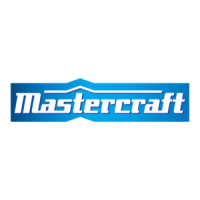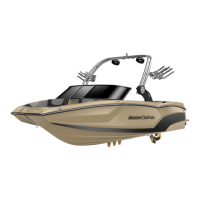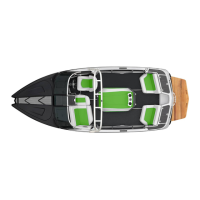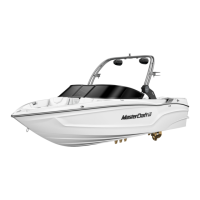
Do you have a question about the MasterCraft XT25 and is the answer not in the manual?
| Brand | MasterCraft |
|---|---|
| Model | XT25 |
| Category | Boat |
| Language | English |
General safety principles and awareness for boat operators, emphasizing additional training.
Discusses the causes of boating accidents and the importance of operator familiarity.
Identifies situations that can result in peril for boats and persons on board.
Details federal law requirements for PFDs and their proper accessibility on board.
Covers specific events that necessitate safety knowledge for boaters.
Lists the federally required safety equipment for inland waters installed at the factory.
Suggests additional equipment for safe and problem-free outings.
Explains the navigation rules for sound signals, including whistle signals.
Details requirements for visual distress signals on coastal waters and the US.
Explains requirements for vessel stops by law enforcement officials.
Discusses state-specific operator license requirements and age restrictions.
Highlights the dangers and penalties associated with boating under the influence.
Details the requirements for registering, numbering, and documenting a vessel.
Outlines federal law requirements for reporting boating accidents.
Covers state speed limits and noise regulations for boat operation.
Explains regulations regarding the improper use of radio-telephones.
Details requirements regarding pollution and discharge of waste.
Notes that not all gauges or switches explained are on every model; some are optional.
Describes manual controls for tabs, ballast pumps, volume, and lights.
Explains instrumentation and control on electronically controlled engines via SAE J1939.
Details the PV1200 unit's display layouts: standard screen and wide screen.
Describes navigation control via touch commands and operating modes.
Displays basic operating info for cruising, with controls for ballast, tabs, and speed.
Explains how to establish fill/drain times for ballast zones and tab crossovers.
Allows control of factory surf profiles, custom profiles, ballast, tabs, and cruise speed.
Guides on creating custom surf profiles by naming, setting speed, tabs, and ballast.
Details three wakeboard profiles for different ability levels: Beginner, Intermediate, Advanced.
Instructions for creating custom wakeboard profiles by naming, setting speed, tabs, and ballast.
Explains the single predefined ski profile and how to activate it.
Guides on creating custom ski profiles by naming, setting speed, tabs, and ballast.
Describes Chill Mode activation for low-speed or stopped operation with stereo controls.
Houses controls for maps, media, volume, lighting, switches, and system settings.
Explains how to access maps and tracking options via the NAVIGATION button.
Details accessing audio sources like Bluetooth, USB, and FM/AM radio.
Guides on connecting phones/MP3 players via USB and Bluetooth for audio playback.
Explains how to customize Bluetooth settings for audio and notifications.
Provides full control over sound zones, including master volume and five individual zones.
Describes how to turn exterior lights ON/OFF and adjust intensity and color.
Explains how to control blower, bilge pumps, seat heaters, and cockpit heater.
Allows adjustment of system settings like units, fuel management, depth alarms, and brightness.
Provides instructions for managing Bluetooth connections and devices.
Guides on connecting to a Wi-Fi network for software updates.
Details the fuel management software that tracks fuel flow and remaining fuel.
Accesses engine, PDM, EPDM, and Tab diagnostic information.
Shows active and stored faults, with navigation to advance or go back between faults.
Displays faults for outputs, inputs, and CAN communications for PDM modules.
Provides critical engine and electrical system operating info from the EPDM.
Offers options for Waypoint Manager, Track Manager, Chart/Time Settings, Depth/Position.
Lists existing waypoints to view, edit, or delete, and plot courses.
Displays recorded tracks, allowing editing, showing, hiding, or deleting.
Allows users to turn ON or OFF display parameters like grids, text, waypoints, and tracks.
Selects map display format for location: Degrees, Minutes, Seconds, or Decimal Degrees.
Allows alarm display when boat detects water depth at or above selected depth.
Changes map display color based on water depth relative to selected depth.
Details compatibility and connection of GoPro cameras with the dual screen dash.
Provides step-by-step instructions for attaching and removing cameras from transom mounts.
Details the innovative fuel system design, safety components, and handling procedures.
Explains minimum fuel requirements and risks of low fuel for wake surfing.
Introduces Ilmor Marine Engines and provides contact information for inquiries.
Provides critical information on proper gasoline use and potential engine damage from low octane.
Lists essential checks and services for safe boating before, during, and after each outing.
Explains the importance of the first 50 hours for establishing wear parameters and drivetrain life.
Provides critical procedures for operating the boat for the first time.
Details pre-start checks, including engine cover inspection and drain plug checks.
Covers shifting gears, warming up the engine, and operating the boat underway.
Provides step-by-step instructions for safely stopping the boat's engine.
Presents basic operational principles, not intended for all conditions encountered.
Emphasizes not overloading the boat and proper weight distribution for performance and safety.
Explains steering response factors and slow-speed maneuvering challenges.
Advises against attempting maneuvers performed by professional drivers.
Provides guidance on approaching docks, tying up the boat, and monitoring moored boats.
Details proper use of stern eyes or sling systems for hoisting the boat from the water.
Explains proper support of the hull in a storage cradle to prevent load damage.
Discusses galvanic corrosion and salt water corrosion prevention methods.
Explains metal decomposition due to electrolytic action and the role of anodes.
Details how to prevent corrosion in salt, polluted, or brackish water.
Provides steps for rinsing and cleaning metal components and hardware after salt water use.
Addresses accelerated marine growth and the use of anti-fouling bottom paint.
Offers guidance on periodic cleaning of the boat's hull and exterior surfaces.
Provides instructions on washing the boat hull with mild detergent and warm water.
Suggests washing carpet with mild detergent and warm water for cleaning.
Offers advice on cleaning and maintaining wood and SeaDek platforms.
Provides cleaning recommendations for PE/EVA nonskid materials using Dek Magic.
Recommends regular, gentle cleaning with mild soap and warm water for swim platforms.
Advises using normal glass cleaners and avoiding harsh chemicals for windshield cleaning.
Provides care and cleaning steps for bimini tops and boat covers made of polyester fiber.
Recommends using only natural soaps and cold water for machine washing canvas covers.
Details emptying and cleaning procedures for the enclosed head system on X26 models.
Provides guidance on cleaning vinyl upholstery to maintain its condition.
Offers advice on cleaning upholstery and avoiding damage from improper use or storage.
Discusses anchor operation, storage, and troubleshooting for proper anchoring.
Explains the purpose and care for various styles of canvas covers.
Details the purpose, location, and operation of optional bimini tops.
Describes the operation of ZFT2, ZFT4, and ZFT7 tower biminis.
Explains the purpose and operation of the ProStar bimini for cockpit shade.
Covers protection for the swim platform from elements using Velcro flaps.
Details anti-pooling covers designed to prevent water and debris intrusion.
Explains the installation and operation of optional sunshades for added shade.
Standard on all models, this procedure rinses internal engine parts after salt or brackish water use.
Provides operation and maintenance for the onboard head system.
Outlines monthly and yearly maintenance tasks for the toilet and sanitation hoses.
Details procedures for winterizing the macerator toilet and sanitation hoses.
Provides guidelines for storing and cleaning removable coolers.
Explains operation, special attention, and troubleshooting for the boat's refrigerator unit.
Details operation and maintenance of the wet bar's freshwater system and drain.
Discusses proper use and maintenance of storage compartments.
Explains the purpose, location, and operation of boarding ladders, including safety precautions.
Describes bow seating and the optional bow lid, including weight limits and safety.
Emphasizes using designated seating and safety precautions while underway.
Explains the operation and troubleshooting for the helm seat's height adjustment mechanism.
Details how to adjust convertible seats for forward/rear facing or sunpad configurations.
Provides instructions for removing and installing two removable rear seats.
Describes how to stow surfboards in sleeves mounted on Bimini canvas.
Details compatibility and mounting locations for GoPro cameras with the dual screen dash.
Provides instructions for attaching, aiming, and removing cameras from transom mounts.
Provides contact information and directs users to the Ilmor Owner's Manual for engine specifics.
Offers critical information on gasoline use, avoiding alcohol fuels, and long-term storage.
Addresses issues like the fuel pump not running and potential causes and remedies.
Troubleshoots issues where the fuel pump runs but the engine does not start.
Lists essential pre-launch checks including engine, weather, safety equipment, and hull integrity.
Emphasizes frequent checks of gauges, controls, vibration, and securing items.
Details post-operation checks for fluid leaks, ballast systems, and propeller/rudder condition.
Warns against removing factory oil before 10 hours and stresses following procedures.
Advises careful monitoring of oil level due to potential high consumption during break-in.
Stresses immediate engine shutdown if gauges indicate problems like low oil pressure or overheating.
Highlights that vibrations or noises may indicate loose hardware or drive line issues.
Warns about safety threats from leaks and advises prompt action if any are found.
Instructs to avoid constant RPM for more than three minutes during break-in.
Recommends quick planing followed by slowing to a slower speed to avoid engine load.
Emphasizes that initial hours significantly affect engine and drive train performance.
Explains operation after break-in period, including RPM limiters and warming up the engine.
Warns that failure to follow engine oil recommendations can cause damage and void warranty.
Covers pre-start checks like engine cover inspection, drain plugs, and bilge blower operation.
Details the process of starting the engine, including key insertion and the START-STOP button.
Explains shifting gears, warming up the engine, and operating the boat underway.
Provides instructions on smooth gear shifting and the neutral safety switch.
Advises checking gauges for oil pressure and overheating, and raw water system blockage.
Provides step-by-step instructions for safely stopping the boat's engine and electrical system.
Emphasizes not overloading the boat and proper weight distribution for performance and safety.
Advises knowing distress signals and offering assistance, reviewing the Safety section.
Promotes respecting others on water, keeping distance, slowing in crowded areas, and being aware.
Provides general guidelines for operating the boat for the first time on the water.
Recommends starting in calm water with room to get a feel for the boat's controls.
Explains steering response factors and slow-speed maneuvering challenges.
Advises against attempting maneuvers performed by professional drivers.
Warns about unknown waters, obstacles, rivers, man-made lakes, and debris.
Provides guidance on approaching docks, tying up the boat, and monitoring moored boats.
Provides contact information and directs users to the Ilmor Owner's Manual for engine specifics.
Offers critical information on gasoline use, avoiding alcohol fuels, and long-term storage.
Addresses issues like the fuel pump not running and potential causes and remedies.
Troubleshoots issues where the fuel pump runs but the engine does not start.
Lists essential pre-launch checks including engine, weather, safety equipment, and hull integrity.
Emphasizes frequent checks of gauges, controls, vibration, and securing items.
Details post-operation checks for fluid leaks, ballast systems, and propeller/rudder condition.
Warns against removing factory oil before 10 hours and stresses following procedures.
Advises careful monitoring of oil level due to potential high consumption during break-in.
Stresses immediate engine shutdown if gauges indicate problems like low oil pressure or overheating.
Highlights that vibrations or noises may indicate loose hardware or drive line issues.
Warns about safety threats from leaks and advises prompt action if any are found.
Instructs to avoid constant RPM for more than three minutes during break-in.
Recommends quick planing followed by slowing to a slower speed to avoid engine load.
Emphasizes that initial hours significantly affect engine and drive train performance.
Explains operation after break-in period, including RPM limiters and warming up the engine.
Warns that failure to follow engine oil recommendations can cause damage and void warranty.
Covers pre-start checks like engine cover inspection, drain plugs, and bilge blower operation.
Details the process of starting the engine, including key insertion and the START-STOP button.
Explains shifting gears, warming up the engine, and operating the boat underway.
Provides instructions on smooth gear shifting and the neutral safety switch.
Advises checking gauges for oil pressure and overheating, and raw water system blockage.
Provides step-by-step instructions for safely stopping the boat's engine and electrical system.
Emphasizes not overloading the boat and proper weight distribution for performance and safety.
Advises knowing distress signals and offering assistance, reviewing the Safety section.
Promotes respecting others on water, keeping distance, slowing in crowded areas, and being aware.
Provides general guidelines for operating the boat for the first time on the water.
Recommends starting in calm water with room to get a feel for the boat's controls.
Explains steering response factors and slow-speed maneuvering challenges.
Advises against attempting maneuvers performed by professional drivers.
Warns about unknown waters, obstacles, rivers, man-made lakes, and debris.
Provides guidance on approaching docks, tying up the boat, and monitoring moored boats.
Explains metal decomposition due to electrolytic action and the role of anodes.
Details how to prevent corrosion in salt, polluted, or brackish water.
Provides steps for rinsing and cleaning metal components and hardware after salt water use.
Addresses accelerated marine growth and the use of anti-fouling bottom paint.
Covers cleaning and polishing for stainless steel, chrome, and anodized aluminum parts.
Provides instructions on washing the boat hull with mild detergent and warm water.
Suggests washing carpet with mild detergent and warm water for cleaning.
Offers advice on cleaning and maintaining wood and SeaDek platforms.
Provides cleaning recommendations for PE/EVA nonskid materials using Dek Magic.
Recommends regular, gentle cleaning with mild soap and warm water for swim platforms.
Advises using normal glass cleaners and avoiding harsh chemicals for windshield cleaning.
Provides care and cleaning steps for bimini tops and boat covers made of polyester fiber.
Recommends using only natural soaps and cold water for machine washing canvas covers.
Details emptying and cleaning procedures for the enclosed head system on X26 models.
Provides guidance on cleaning vinyl upholstery to maintain its condition.
Offers advice on cleaning upholstery and avoiding damage from improper use or storage.
Discusses anchor operation, storage, and troubleshooting for proper anchoring.
Explains the purpose and care for various styles of canvas covers.
Details the purpose, location, and operation of optional bimini tops.
Describes the operation of ZFT2, ZFT4, and ZFT7 tower biminis.
Explains the purpose and operation of the ProStar bimini for cockpit shade.
Covers protection for the swim platform from elements using Velcro flaps.
Details anti-pooling covers designed to prevent water and debris intrusion.
Explains the installation and operation of optional sunshades for added shade.
Standard on all models, this procedure rinses internal engine parts after salt or brackish water use.
Provides operation and maintenance for the onboard head system.
Outlines monthly and yearly maintenance tasks for the toilet and sanitation hoses.
Details procedures for winterizing the macerator toilet and sanitation hoses.
Provides guidelines for storing and cleaning removable coolers.
Explains operation, special attention, and troubleshooting for the boat's refrigerator unit.
Details operation and maintenance of the wet bar's freshwater system and drain.
Discusses proper use and maintenance of storage compartments.
Explains the purpose, location, and operation of boarding ladders, including safety precautions.
Describes bow seating and the optional bow lid, including weight limits and safety.
Emphasizes using designated seating and safety precautions while underway.
Explains the operation and troubleshooting for the helm seat's height adjustment mechanism.
Details how to adjust convertible seats for forward/rear facing or sunpad configurations.
Provides instructions for removing and installing two removable rear seats.
Describes how to stow surfboards in sleeves mounted on Bimini canvas.
Details compatibility and mounting locations for GoPro cameras with the dual screen dash.
Provides instructions for attaching, aiming, and removing cameras from transom mounts.
Defines key terms used in maintenance: Check, Inspect, and Change.
Recommends break-in procedures performed by authorized MasterCraft technicians.
Lists essential pre-use checks including engine, safety equipment, and battery connections.
Details post-use maintenance like cleaning, corrosion prevention, and system flushing.
Specifies checks for safety equipment and oil changes at 50-hour intervals.
Recommends annual maintenance by authorized MasterCraft dealers for optimal service.
Details inspection of engine mounts for tightness and proper condition.
Highlights critical maintenance for avoiding wear and damage to the propeller and shaft.
Provides instructions for inspecting exhaust flaps for deterioration and replacement if needed.
Guides on lubricating steering systems for cable and hydraulic types.
Details checking/replacing ballast pump impellers, applicable to X and XStar boats.
Covers inspection of fuel system for leaks and changing the fuel filter.
Recommends checking fire suppression and extinguisher units annually for readiness.
Outlines owner responsibilities for routine and annual maintenance per engine manual.
Lists supplies needed for storage, including fuel stabilizer and fuel filter.
Details preparation for extended storage, including fuel stabilization and water condensation concerns.
Provides steps for winterizing the boat, including lubricating cables and checking batteries.
Explains winterization procedures for ballast tanks, pumps, and fittings to prevent freezing.
Guides on removing duct tape, charging batteries, and reactivating the engine and drive train.
Covers checking/repairing propellers and changing propellers, including safety precautions.
Provides steps for checking propeller shaft alignment and propeller condition.
Details the step-by-step process for removing and installing a propeller.
Congratulates on trailer purchase and outlines the purpose of the Owner's Manual section.
Provides NHTSA contact information for reporting safety defects.
Encourages reading the manual before first use for trailer information.
Highlights the importance of matching the trailer to the boat for quality and experience.
Offers tips on trailer maintenance, focusing on paint chipping and lubrication.
Advises checking the braking system at the beginning and end of season.
Recommends approaching the trailer slowly for better control when hitching.
Explains the necessity of a seven-wire connector for trailer lights and brakes.
Details how to determine load limits and the importance of not exceeding capacity.
Emphasizes visual inspection of the trailer before and during trips for potential issues.
Provides techniques for backing up, parking, and uncoupling the trailer.
Explains the importance of proper weight distribution for stability and safety while towing.
Discusses weight-carrying and weight-distribution hitches and their proper use.
Explains the function and importance of safety cables for preventing trailer detachment.
Details the breakaway cable's purpose, installation, and resetting procedure.
Provides instructions for checking and resetting the breakaway cable system.
Covers winch operation, maintenance, and safety precautions.
Explains the proper folding and securing of the swing tongue for towing.
Provides step-by-step instructions for connecting the trailer to the tow vehicle.
Emphasizes ensuring trailer lights are in proper working order before each use.
Describes XKGlow trailer runway lights and refers to the operating manual.
Provides tips for maintaining trailer lighting, including ground wire and bulb checks.
Details maintenance for Vortex hubs, spindles, grease, and bearings.
Explains how to add grease or remove Vortex hubs and spindles.
Covers checks for lug nuts, lubrication, tire pressure, and cleaning of wheels.
Explains the importance of proper lug nut torque and size for safety.
Discusses common trailer tire issues like under-inflation, wear patterns, and replacement.
Compares disc brakes to drum brakes and covers maintenance for trailers with brakes.
Explains the function of the reverse lock-out solenoid and manual brake lockout.
Provides a procedure for manual brake bleeding, recommending professional service.
Details maintenance for the trailer jack, including greasing and checking function.
Emphasizes securely holding the boat on the trailer using tie-downs.
Provides step-by-step instructions for connecting the trailer to the tow vehicle.
Offers advice on compensating for trailer length, weight, and width during driving.
Recommends applying common sense to general driving situations.
Advises a trial run to familiarize with trailer handling characteristics.
Recommends moderate speeds for less strain on vehicle and trailer, and to avoid sway.
Highlights the need for extra time and space when passing and stopping.
Provides guidance on safe passing procedures, including signaling and avoiding soft shoulders.
Warns against sudden maneuvers that can cause trailer sway.
Emphasizes the need for extra stopping distance due to trailer weight and braking system.
Recommends installing and checking rear view mirrors for proper trailer visibility.
Explains the need to swing wider in turns due to trailer wheel placement.
Warns against using vehicle brakes to control trailer sway, as it can worsen the condition.
Advises preparation for wind buffeting and maintaining a firm grip on the steering wheel.
Warns against towing with towers in the down position to prevent premature wear.
Highlights that sudden stops can cause skidding or jack-knifing.
Emphasizes using turn signals to communicate intentions to other vehicles.
Provides guidance on using appropriate gears for driving conditions to ease load on the vehicle.
Encourages courtesy to faster vehicles by remaining in the slower lane and reducing speed.
Offers advice on launching and retrieving the boat, including checking the ramp and using depth stickers.
Advises checking ramp conditions (steepness, firmness, depth) before launching.
Provides tips for backing up a trailer, including using a spotter and proper steering wheel technique.
Details state/municipal requirements for permits, licenses, and equipment for towing.
Lists pre-towing checks for vehicle and trailer, including lights, tires, and security.
Emphasizes performing safety checks before towing a MasterCraft trailer.
Outlines routine maintenance procedures to prevent failures and ensure safety.
Warns that failure to follow maintenance procedures can lead to component failure, injury, or death.
Disclaims all other warranties and limits implied warranties.
Details warranty periods for hull, gel coat, engine, and screens.
Warrants structural components for the life of the original owner.
Warrants gel coat for stress crazing for one year, excluding scratching or fading.
Provides engine warranty for seven years or 1000 hours, whichever occurs first.
Warrants electrical display screens for three years or 600 hours.
Warrants SeaDek components for two years or 600 engine hours.
Warrants all other components for five years from the In-Service Date.
Warrants trailer components for five years, paint for one year.
Defines warranty periods and start dates, including Model Year and In-Service Date.
Outlines limitations and exclusions due to factors outside MasterCraft's control.
Excludes damage from misuse, negligence, accidents, collisions, or impacts.
Excludes damage from unauthorized alterations, modifications, or repairs affecting capacity or horsepower.
Excludes damage resulting from the use of improper or contaminated fuel or fluids.
Excludes damage from customer-applied chemicals or accidental spills.
Excludes damage from failure to maintain the boat per the Owner's Manual or improper repairs.
Excludes damage from failure to comply with recalls or repair requests from MasterCraft.
Excludes damage from using the boat for racing, speed, commercial competition, or performance demonstrations.
Excludes damage from using the boat for rental, commercial, or industrial purposes.
Excludes damage to hardware and components fastened to the hull, deck, or liner.
Excludes damage from fire, theft, freezing, vandalism, natural disasters, or weather.
Excludes damage caused by using a non-MasterCraft trailer for transport, movement, or storage.
Excludes damage from improper support using davits, hoist systems, or boat lifts.
Excludes damage to surfaces, coatings, and from in-water storage without proper protection.
Excludes trailer damage from abrasions, rock chips, rust, improper care, or salt water use.
Excludes damage caused by dealer-installed options or accessories.
Excludes normal wear and tear items like batteries, bulbs, fuses, and filters.
Details warranty conditions for commercial, special use, and demo boats.
Defines a Commercial Boat as one used to generate income.
Specifies warranty limitations for commercial boats based on service date and engine hours.
Defines Special Use Boats and outlines warranty limitations for consignment or photo boats.
Defines Demo Boats as those reaching 50 hours or engine usage before retail sale.
Limits MasterCraft's liability, excluding consequential damages.
Excludes incidental, consequential, special, indirect, punitive damages, or lost profits.
Limits MasterCraft's liability to repair, replacement, or refund of purchase price.
Explains the process and conditions for transferring the limited warranty to a second owner.
Provides instructions for submitting warranty claims to MasterCraft service department or factory.
Details steps for registering the boat's warranty with MasterCraft.
Explains the process for transferring the warranty to a second owner upon resale.











